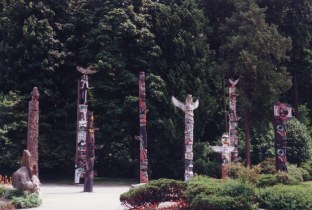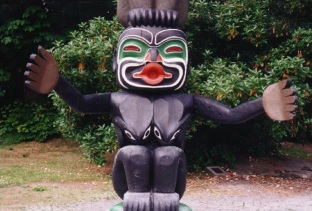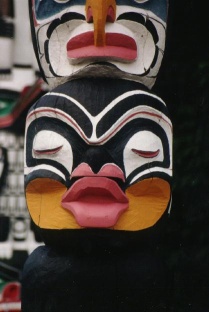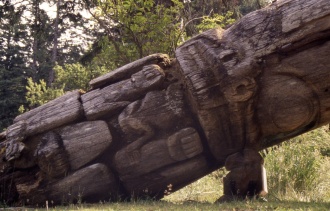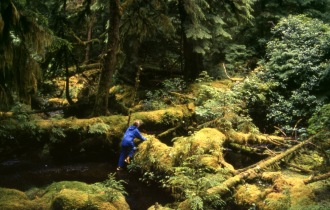Emily Carr House
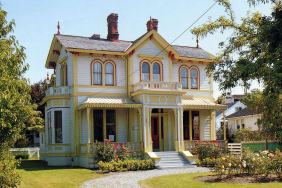
![]() Beautifully renovated and open to the public, this is the house where Emily was born and where her sisters continued to live while she was in Vancouver and Europe, and later when she lived in her nearby apartment house. Numerous family artifacts are displayed in her bedroom, and eighteen original Carr works are exhibited. Open mid-May to mid-October.
Beautifully renovated and open to the public, this is the house where Emily was born and where her sisters continued to live while she was in Vancouver and Europe, and later when she lived in her nearby apartment house. Numerous family artifacts are displayed in her bedroom, and eighteen original Carr works are exhibited. Open mid-May to mid-October.
207 Government St. Victoria, B.C. V8V 2K3
(250) 383-5843
If you're unable to visit in person, take a
virtual tour
of the house and grounds, accompanied by Emily's own words.
House of All Sorts
Emily Carr's apartment and boarding house from 1913 to 1916, The House of All Sorts is
currently a private residence, not open to visitors, but you can visit it virtually,
including the Eagles in the attic.
Beacon Hill Park
At the foot of Douglas Street and west of Cook Street just south of downtown Victoria lies the 200-acre Beacon Hill Park, a beloved haunt of Emily Carr, a place instrumental in shaping her early love for nature, particularly trees and birds.
|
|
|
|
In her journal, Hundreds and Thousands, she wrote: "Dear Mother Earth! I think I have always specially belonged to you. I have loved from babyhood to roll upon you, to lie with my face pressed right down on to you in my sorrows. I love the look of you and the smell of you and the feel of you."* And this recollection of her childhood spent in the Park: "I can remember when the park was full of woods and wild flowers, and owls hooted and there were lady-slippers and wild lilies and the lakes were swampy pools with thick scraggly growth 'round and in them."**
Varieties of trees native to Beacon Hill Park are Garry oak, arbutus, Douglas-fir, red cedar, and maple. Birds nesting here or passing on annual migrations are bald eagles, herons, Canada geese and peacocks. Emily's favorite parts of the Park were the virgin stands of fir and the overlook onto the Strait of Juan de Fuca. She would certainly have known of the petroglyphs and clamsell middens of aboriginal dwellers of this tract of land inhabited as early as 14,000 years ago. The world's tallest free-standing totem pole (128 feet), created by Kwakwaka'wakw carver Mungo Martin in 1956 is here in the Park.
Museum of Anthropology at the University of British Columbia
A museum designed to house monumental totem poles
must be grand indeed, as this is.
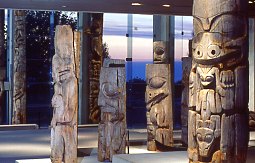
|
|
Haida Pole Fragments, Great Hall, Museum of Anthropology, Vancouver. Photo: Bill McLennan. |
Here is a fabulous collection of First Nations material including totem poles, feast dishes, basketry, tools, bent wood boxes, masks--all beautifully displayed in a purpose-built museum using traditional Northwest Coast post and beam construction. Fifteen-meter-high windows take the eye outdoors to two Haida Big Houses, ten full-scale Haida, Gitksan, and Nisga'a poles, two carved house posts and two contemporary welcome figures, all overlooking the sea.
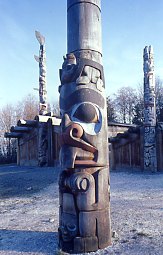
|
|
Haida Houses and Outdoor Poles, Museum of Anthropology, Vancouver. Photo: Bill McLennan. |
The museum's entire
collection, vast though it is, is available for perusal. Some actual totems Carr painted
are here, including Totem Mother, Kitwancool. A nine-foot Dzunukwa feast dish similar
to what appears in The Forest Lover is a particularly startling piece.
Museum of Anthropology at the University of British Columbia
6393 N.W.Marine Drive Vancouver, B.C. V6T 1Z2
Recorded message (24 hr) 604-822-3825 Telephone (M-F) 604-822-5087
Ross Bay Cemetery
1594 Fairfield Road. Victoria
The Carr family plot is #85 E, and Emily's grave is #85 E 15.
St. Paul's Roman Catholic Church, Squamish Mission Reserve, North Vancouver
424 West Esplanade, North Vancouver
The first chapel was built around 1866 by French Oblate missionaries, replaced in 1884 by
the Church of the Sacred Heart which Sophie attended, and enlarged in 1909 in Gothic Revival
style suggestive of the churches of French-Canada and France. Renamed St. Paul's at that time,
it is the oldest surviving mission church in the Vancouver area. The twin spires once served
as a landmark guiding ships entering Vancouver Harbor.
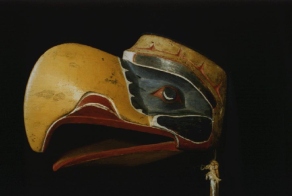 Photo of Kwakwaka'wakw Eagle Mask courtesy of U'mista Cultural Society.
Photo of Kwakwaka'wakw Eagle Mask courtesy of U'mista Cultural Society.
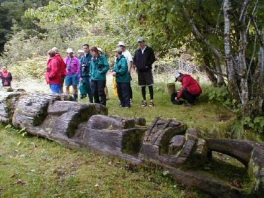 Photo of Mimkwamlis courtesy of Thomas Sewid.
Photo of Mimkwamlis courtesy of Thomas Sewid.
